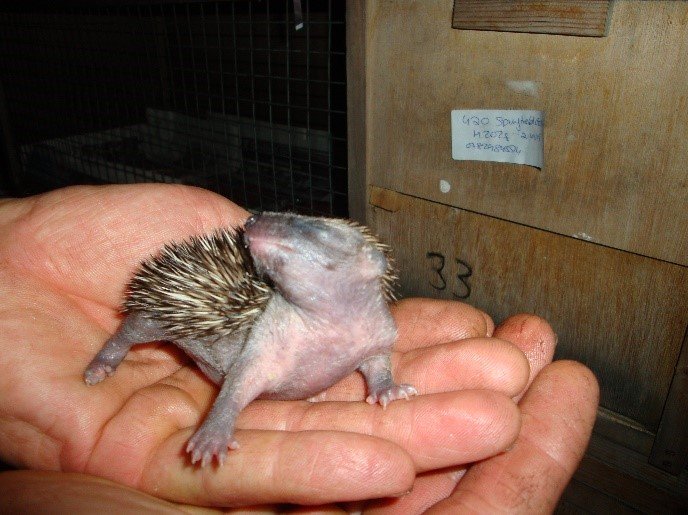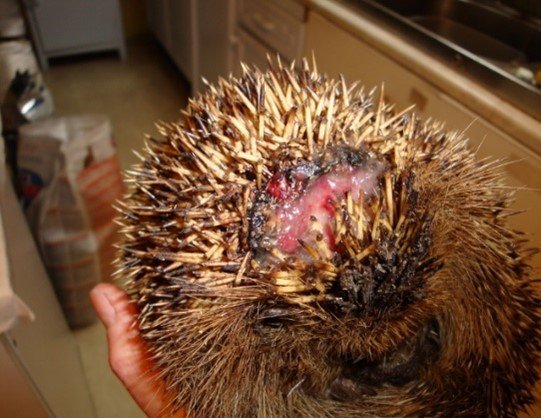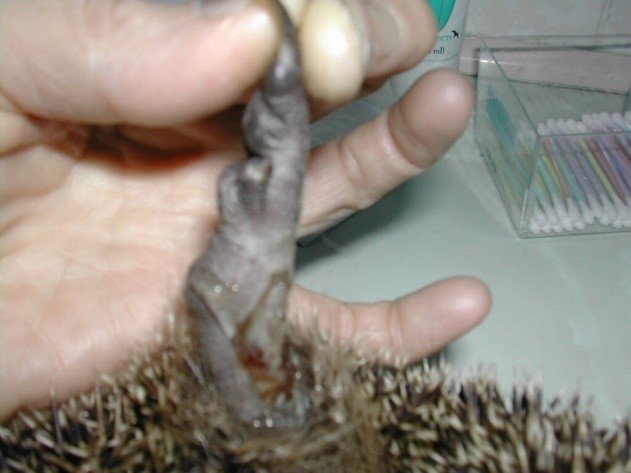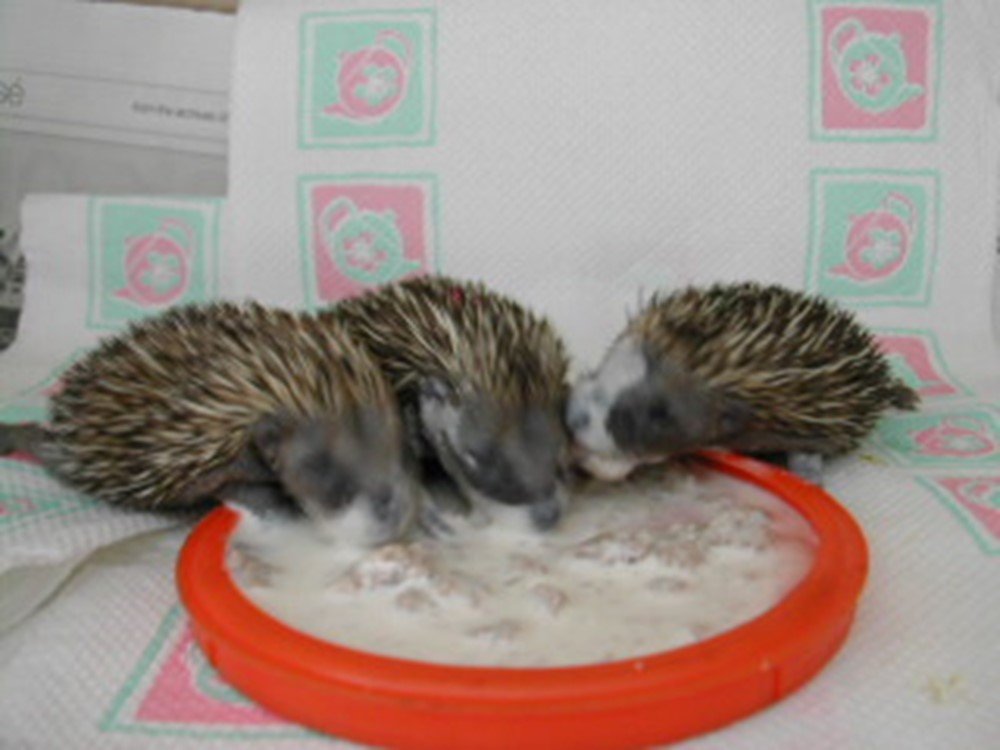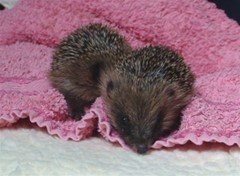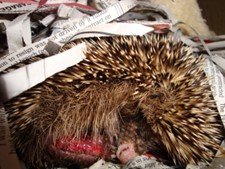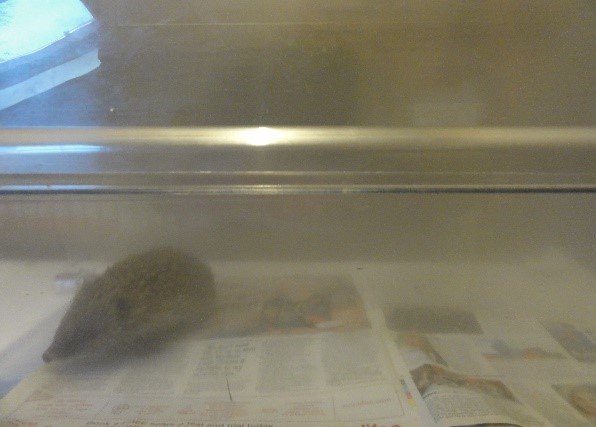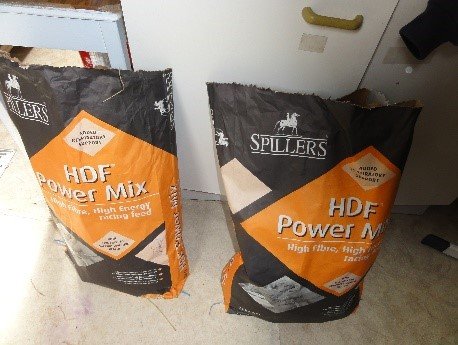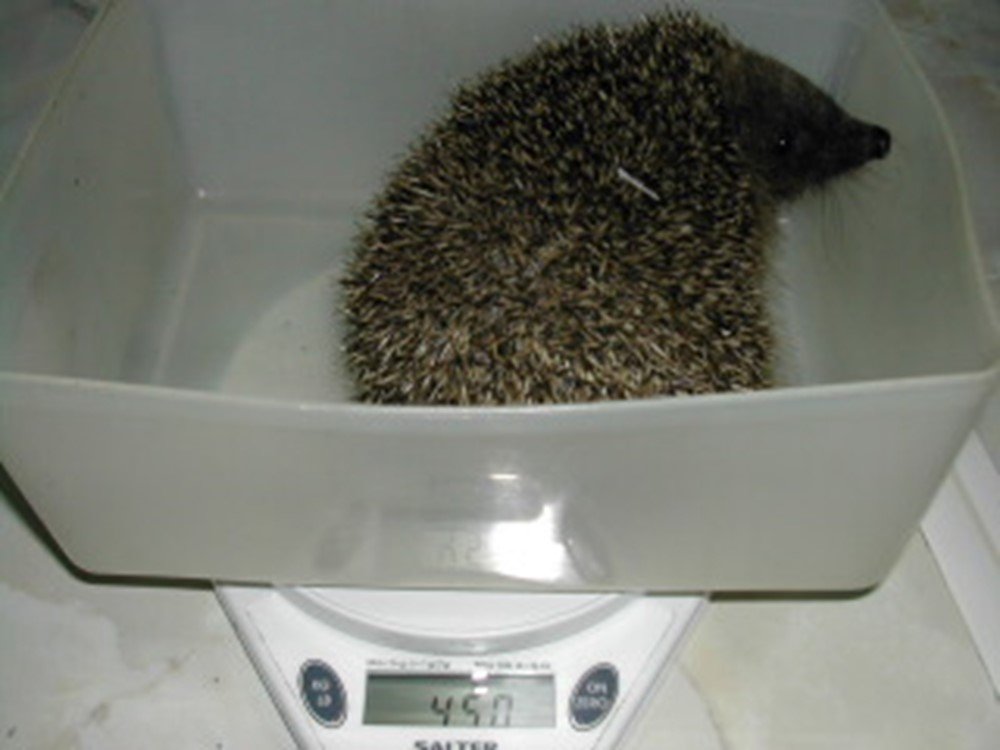Hedgehog Care
This section is intended for hedgehog rehabbers or those thinking of setting up their own rescue, if you are a member of the public who has found a hedgehog in need of help, please contact us on 01534 734340 if you are in Jersey or your local vet or wildlife hospital if you are in the UK. Please do not attempt DIY rehab yourself. In Jersey you are only permitted to keep injured or sick wildlife for a maximum of 48 hours without a licence from the Environment Department.
If you would like more information about how we look after hedgehogs, hand rearing hoglets and endoparasites, their treatment and identification, please download Dru’s brain
-
The first time you pick up the hog may be the only time you get to see its underside for quite a long time! So make sure you check it has 4 uninjured legs and feet, and that there are no maggots or fly eggs on its tummy and round its anus, and of course check its sex, you will need this for the records anyway! Some people use a mirror to help.
The next question to ask yourself is, is it a proper hedgehog shape? Is it symmetrical, are there any bulges round its face and head? Are all its legs OK and not swollen? Are there any wounds anywhere? Does it smell OK?? Not of rotting flesh! Hoggy smell is OK! If there is anything odd about its shape, it will need to see a vet and if you are unsure how urgent it is, better to take it sooner than later.
-
Admission forms/record sheets - It is vital to record the basic facts about any hedgehog in your care.
Find out from the finder where and when they found the hog, and their address and phone number if it is to be released back with them. Only keep this information for as long as you need to and only record what you need, because of GDPR. If finders do not want to release the hog in their garden we don't take any details now, if they want a progress report they can ring us.
Give it an admission number or name.Weigh the hog and record its admission weight. Sex it and record its sex.
-
If the hedgehog is in a tight ball and you really cannot sex or examine it, just put it in its hutch/box/cage and try later or the next day when you clean it out. If it is half unrolled, you can either jiggle it up and down on your hands until it unrolls, or put it on the work surface and gently press on its back and roll it onto its side a bit so you can see its underside, or if you can get the hind legs, hold both of them and do a “wheelbarrow” with it so you can check its tummy and legs.
If you think it is injured or has a ligature, netting or plastic round it which it will not let you remove, then take it to the vets for anaesthetic.
-
Put the hog in a heated hutch with some bedding - we use shredded newspaper for a nest and give it a bowl of water and some tinned/wet and dry food. Once the hog is settled in its hutch give it a label on the hutch door, with its number, sex, date admitted. Make a note of which hutch you have put it in on its record sheet and continue to note all the hutches and pens it uses, in case of an outbreak of some contagious disease e.g. ringworm, you will be able to know which hogs have used each pen or hutch.
Rule of thumb, if the hog was found out in daylight, it is going to need antibiotic cover and possibly fluid therapy. Start worming the day after admission - if this is necessary.
Hygiene: If you have long hair and especially if you are blonde/grey (now we are all getting older!) it makes it harder to see loose hairs which may get caught round hogs’ legs or bodies, especially if they are babies, so it is advisable to tie back and up any long hair! Also nicer if you are dealing with maggots etc! Hairs can get wrapped tightly round hogs’ legs and cut off blood supply.
Wash your hands before and after handling hogs and change gloves in between each patient or family. Keep littermates together, but do not be tempted to put unrelated hoglets together until they are big enough to go in an outside pen (400g in summer - bigger as the year goes on), as you will only risk spreading infection.
Zoonoses - Hedgehogs can carry all sorts of bacteria (Salmonella, E Coli etc) and also ringworm which can be transmitted to humans, I think there are about 14 different things which we can catch from them.
-
To inject under the skin, pull up a few spines with your (left if you are right handed) hand and with your (right) hand inject just under the skin, so the tip of the needle feels free and is not in the muscle at about 45 degree angle. We all wear disposable gloves now when working with hogs.
Most hogs will fall into the following categories:
- Thin and dehydrated/ possibly with diarrhoea (worms)
- Breathing and chest problems (worms)
- Injuries/wounds / Abscesses
- Hogs which have become trapped in something, netting, swimming pools, sheds, holes, drains…..
- Orphans, either not yet weaned or partially or fully weaned.
-
Use the record sheet to note weight, what the hog has eaten and what it has passed during the preceding 24 hrs, and what medicines you are giving it. Take this sheet with the hog to any vet’s appointment so you can show the vet what you have been doing and can answer any questions!
-
You can tell a hog is dehydrated because it will look flat and listless and probably be very thin, when you pinch some spines and pull them away from the body, they will not “ping” back quickly but go back sluggishly.
Its eyes will be sunken in - you may not even be able to find them at first. If you give rehydration fluid and it isn’t needed it will just pee it out anyway, with no harm done, better to give too much than too little! Give 10% of body weight during a 24 hr period (or more if hog is really flat) No 11 Hartmanns solution is for hogs dehydrated and with diarrhoea.
No 1 normal saline is for flushing out wounds and using in nebuliser. Do not put too much fluid at any one site, 5ml is about the maximum for an adult hog at one site, warm the syringes before administering. Make sure that the heat pad in the hutch is on, especially important for cold dehydrated hogs. The hog will need antibiotic cover, decide on which a/b according to symptoms: DIARRHOEA in addition to rehydration fluid give Norodine/ Diatrim 24 0.6ml/kg and Buscopan 0.1ml if very runny and/or in pain - can be given 3 times a day if yelling a lot.
-
Try Synulox (0.7 ml per kg b/w ) for chesty hog, Ventipulmin injectable 0.1ml/kg twice a day change after 10 days to Ceporex (0.2ml/kg). If it makes a noise when breathing in only it's nasal congestion, if it makes a noise when breathing out and you can probably feel it rattle if you hold the hog on its back on your hand for a very short time, this will squash its lungs so not nice for the patient, then it’s a chest problem.
If its sides heave when it breathes and makes noises breathing in and out, take it to your vet and possibly get it x-rayed - may have abscess or tumour or some other major problem which isn‘t treatable……Dexamethasone is good for some respiratory problems.
We have got a nebuliser which seems to be working, I have been giving them 2 ten minute sessions a day, it seems very effective for old snotty pigs, and new arrivals with lungworm and chest infections.
Once they come out of the nebuliser they often start eating at once - their noses must be clearer and they must be able to smell the food! Other rescues use drugs in their nebulisers, but so far I have been using saline with a tiny bit of F10 concentrated antiseptic in it 1:250 is what is recommended on the bottle, so that is only 0.1ml F10 to 25ml of saline. You can use a mask to nebulise but to save time I got a box to put the hogs in so I can get on with cleaning out its accommodation and do another few while each one is in the chamber!
-
How to do a direct faecal smear Take a yucky bit of poo, green or slimy and put a tiny smear on a slide, put a drop of water on it and mix a bit with the knife, then put cover slip on top and clean off excess with loo roll. Place slide on microscope and move around so you look at the whole coverslip, record what you see and treat accordingly.
In practice don’t worry about the 3 different types of Capillaria (roundworm) they are all treated the same anyway. Vale are recommending Ivomec Super (0.5ml/kg give 3 doses one week apart) tor Capillaria and Advocate dog (make sure it is DOG not cat as they are different) (0.3ml/kg 2 doses, second dose 10 days later) for Crenosoma.
I am still using Droncit for fluke, Vale recommend Profender. You will need 50mg/kg Praziquantal in whatever form you are giving it. See Dru’s brain for dose rates for wormers
After Fluke damage or for liver damage or problems give Synulox, Dexamethasone and B12 for 5-10 days. If hogs aren't eating Dex and vit B12 injected together with antibiotic cover can pick them up and improve appetite along with worming treatment. Our vets cannot get B12 on its own now we have a Vit B complex injection.
-
Give Synulox (0.7ml/kg) and Rimadyl/Carprofen (0.1ml/kg) and 10% b/w No 11 Hartmanns fluid if there is an open wound, hog has lost a lot of blood or looks dehydrated. See a vet as soon as possible. To clean up a wound clip spines round the wound and remove grotty scabby bits with forceps, clean round the wound with saline on a wad of damp cotton wool. Flush wound with saline Aqupharm No 1- warm it up first. Flush well with needle on syringe to give greater pressure, or just with syringe.
For wounds which track back under the skin, this often happens as the spine coat is only loosely connected to body, to enable hogs to roll up, so maggots and infection often go a long way back from original wound use a catheter fixed to a syringe to flush and suck out pus and fluid. Clean wound twice a day if necessary or just once as routine, until completely healed.
Raw flesh must be dressed with Intrasite gel or Aloe Vera gel or Vetericyn. Once hog is eating, Antirobe (Zodon) 25mg/kg can be put on food. Clindamycin is a very good antibiotic for smelly wounds and mouth infections as it kills anaerobic bacteria. Manuka honey is also a really wonderful wound dressing and promotes healing fantastically.
-
A spinal injury may be evident by a definite line across the hog’s back where the spines do not stick up but lie flat below the break. It may not be able to move its hind legs, but may not be in pain, all feeling may have gone.
Some pelvic fractures can be healed with cage rest, but hog will need an x-ray and vet examination to confirm it. Sometimes they can retain urine and not be able to defecate, so will need putting to sleep.
Some leg fractures can be pinned to avoid amputation and then the hog can be released when fully recovered.
-
Try to remove these, but if you find it is impossible take the hog to the vets at once, they can do more under anaesthetic or if it is really too bad can put it to sleep.
Maggots can be picked out of a wound with forceps or tweezers, flushed from the eyes and ears, with saline in a syringe.
Apply F10 spray to kill maggots. Fly eggs can be combed out with a flea comb from the fur and brushed off the spines with an old tooth brush. Make sure you check all orifices, eyes, ears, nose, mouth, anus, vulva/penis sheath. Flies like to lay their eggs down the ears and round the bum/groin, and in the folds at the tops of all legs!
Anywhere where it is warm and moist, blood and other bodily fluids will attract them like magnets. They do not lay their eggs on healthy hogs, so make sure you find the reason for the maggot/fly egg infestation, ie wound, diarrhoea, runny eyes, bad teeth etc.
-
Synulox and Rimadyl/Carprofen and Fluid until it eats. Continue on this regime + Dexamethasone after 5 days if breathing still bad.
-
Give Rimadyl 0.1ml and Synulox 0.7ml/kg b/w but NOT Dex. Wait 36-48 hrs to see if starts to eat. Get vet to check for injuries. Ceporex for brain problems or central nervous damage/injury, and Dex after 10 days. DON’T GIVE DEX IF THEY TWITCH or have fits OR ANYTHING SIMILAR. DO NOT GIVE THE FOLLOWING DRUGS ON THE SAME DAY, Dexamethasone and Rimadyl/Carprofen. 2 sorts of sulphonamide ie Tribrissen/Norodine/Septrin/Trimacare/Diatrim/Duphatrim
-
Do not generally cause a problem to the hog unless it is really poorly and anaemic. Fleas can be killed with pyrethrum flea powder anything safe for cagebirds is safe for hogs. DON'T USE FRONTLINE ON HEDGEHOGS. Ticks can be left till they fall off, unless there are loads of them. If you try to pull them off and leave their mouthparts in the hog, the site can go septic, to remove them, use tweezers or a tick remover and use a twisting action. Ivomec helps.
SURFACE MITES will look like sand, put 0.5ml/kg of Ivomec spot on on the skin, may need to repeat it after 10 days, or try puppy or kitten stronghold.
-
MOST IMPORTANT - TAKE A SAMPLE OF THE CRUD,SCABS AND MUCK AND PUT IN PLASTIC BAG BEFORE YOU GIVE ANY TREATMENT SO VETS CAN IDENTIFY MITES AND DO RINGWORM CULTURE.
If Ringworm is found (takes 12 days to culture) get Imaverol from vets and give 4 baths at 3 day intervals (10ml per 500ml water see packet) If you want to check if it is clear wait 10 days then get culture done again, then wait another 12 days for result. We have stopped getting cultures done now we are more familiar with ringworm symptoms, but would do it in severe cases to check if mites and ringworm are both present.
ALL THIS TIME KEEP HOG IN COVERED PEN OR IN HUTCH INSIDE ON ITS OWN, TAKE GREAT CARE WITH DIRTY BEDDING AND WEAR GLOVES ALL THE TIME WHEN DEALING WITH IT. BOTH MANGE MITES AND RINGWORM CAN BE TRANSMITTED TO HUMANS,OTHER HOGS AND PETS SO KEEP CATS AND DOGS AWAY FROM HOG UNTIL IT IS CLEAR OF BOTH.
Imaverol can also be sprayed onto patches of ringworm - diluted as per instructions on the box 1:50 with warm water. lasts for 6 weeks diluted. Vetericyn, tea tree cream 1% (don't use tea tree oil neat on hogs far too strong) and other antifungal preparations (Daktarin, Canestan etc) have also been tried for persistent cases of ringworm.
-
If they are rescued alive from swimming pools, we give them 5 days antibiotic as a precaution in case the chlorine (or whatever pool chemicals are used) has damaged their lungs.
They may also need antibiotic if they have fallen into untreated water - especially filthy drain water, depending on how long they have been there and how bad they are. They may have taken in a lot of water and so their weight may drop dramatically for the first few days, we keep them in care until their weight has stabilised and they seem to have fully recovered. You will probably worm it as well but see if it's necessary.
-
Hogs caught in nets can have nasty injuries, wire, string, plastic rings etc, can all get twisted round limbs or bodies - the blood supply can be cut off , so be very sure that it is all removed and even if there is no obvious sign of injury keep for observation for at least 48 hrs, in case of internal injury, unless it is a lactating female in the breeding season and she looks completely unhurt with no swelling anywhere. You may need the vets’ help with netting hogs.
For Hog’s legs caught in netting give Lasix and Dex and Synulox NOT Rimadyl and MASSAGE the legs to get circulation back. Bathe in WARM water as cold water will shut circulation down. Don’t let bracelets of scab build up, remove and massage and put Intrasite or Vetericyn Gel on them.
-
You may never know for sure if the hog has been poisoned unless the finder owns up. Vitamin K can be given for rat poisoning or if the hog passes blood (0.15ml) inject into the purse string muscle. To wash off oil or tar, use liquid paraffin and then wash well! Lime poisoning wash in water with a bit of vinegar and give liquid charcoal by mouth.
-
Only use Ovex/Ivomec Super if Capillaria are really bad.Don’t give Norodine 24/Diatrim
Safe to use are:
- Engemycin
- Droncit
- Bisolvon
- Ceporex
- Synulox
Kitten/puppy foods are good to build up Mum too! They seem to love Royal Canin Mother and Babycat. If she aborts - take to vets for scan and oxytocin jab 0.2ml twice 24 hr interval.
Any adult female may be pregnant anytime from May to October, if she is in care and suddenly goes off her food, becomes active and makes a nest of all her bedding, she may be about to give birth, so take extra care when cleaning her out!! If there are babies, then take care not to touch them and put Mum and everyone back in the nest box together and leave well alone! She may not feed for 48 hrs after giving birth. They move the babies to a new nest, (so provide a second box in plenty of time) on about day 23.
-
Hoglets are born blind, deaf and with a fluid-filled membrane covering their spines, which disappears soon after birth, the first spines are white and quite soft, there are about 90 of them.
If you admit more than one from a litter, mark the spines with nail varnish, so you can tell who is who, the “big” one can become the “little” one overnight! DON’T MIX LITTERS, keep families together on their own.
For more information please see the hoglets section in Dru’s brain
If you would like more information on Hedgehog care, please email jerseyhedgehogs@hotmail.co.uk and pick my brains!










